Research Areas
Poly(pro-drug) Biomaterials
What are poly(pro-drugs)?
Pro-drugs are chemical derivatives of bioactive molecules designed to improve a property of pharmacological importance (e.g. absorption, biodistribution, metabolism and excretion), which are metabolized into the active drug species. Polymerized pro-drugs (Poly(pro-drugs)) can be fabricated by incorporating the pro-drug in the polymer backbone/repeat unit, and have shown great promise as a means to provide prolonged, tunable delivery of clinical compounds.
Poly-curcumin materials as an intracortical microelectrode coating
Curcumin is a naturally occurring compound found in turmeric that has been shown to have antioxidant, anti-carcinogenic, and anti-inflammatory properties. In neural tissue, it has also been shown to be neuroprotective and promote nerve regeneration. Our lab is developing a novel poly(pro-curcumin) intracortical microelectrode coating to provide prolonged curcumin release at the implanation site. With this approach, we aim to reduce inflammation and provide neuroprotection after electrode implantation, improving electrode function and longevity.
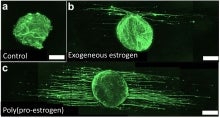
Poly-estrogen materials for treating spinal cord injury
Estrogen, the major female sex hormone, has been shown to exhibit neurotrophic and neuroprotective effects throughout the central nervous system. Specifically, it has been shown to reduce inflammation, glial cell reactivity, oxidative stress, and glutamate excitotoxic neuronal death, while also providing neuroprotection. Our lab has developed poly(pro-estrogen) materials that release estrogen over prolonged, tunable durations to promote neuroprotection and neurite regeneration.
Electrospun Fibers
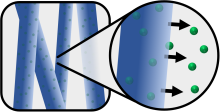
Electrospun fibers for drug and gene delivery
Electrospun fibers alone are often unable to facilitate complete regeneration across critical length injury gaps. Therapeutic drugs and genes can be incorporated onto the surface or encapsulated within electrospun fibers to optimize the therapeutic delivery kinetics and stimulate regeneration. Loading the electrospun fibers with therapeutic drugs and genes that modulate the glial cell response and directly influence axonal regeneration can further improve the regenerative capacity of electrospun fibers. Our lab aims to develop and characterize electrospun fiber-mediated drug and gene delivery systems to optimize the regenerative potential of the electrospun fiber platforms for future use in synthetic nerve grafts.
Figure reproduced from Puhl D. L., et al. Bioengineering 2021.
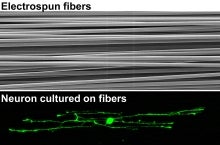
Cell Response to Fibrous Topography
Electrospinning is a fabrication technique used to produce nano- or micro- diameter fibers to generate biocompatible, biodegradable scaffolds for tissue engineering applications. Electrospun fiber scaffolds are advantageous for neural regeneration because they mimic the structure of the nervous system extracellular matrix and provide contact guidance for regenerating axons. Our lab studies the effects of fiber diameter, surface nanotopography, and surface coatings on various cell types, including primary rat neurons and glia. Our lab routinely studies astrocytes and Schwann cells, but have also previously studied macrophages, microglia, and oligodendrocytes.
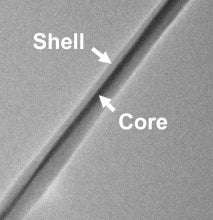
Core-shell fibers
Loading growth factors into electrospun fibers can diminish their bioactivity because of the organic solvents used to dissolve the polymers and the high voltage used to generate the fibers during electrospinning. Coaxial electrospinning avoids these obstacles by utilizing a separate shell and core solution, where an aqueous core can be loaded with proteins and protected from the harsh electrospinning environment by the shell solution. Our lab utilizes coaxial electrospinning to fabricate scaffolds that provide prolonged release of bioactive therapeutics to stimulate a regenerative phenotype in glial cells, reducing inflammation and supporting axonal regeneration after injury.
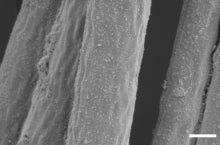
Magnetic composite electrospun fibers
Magnetic composite electrospun fibers can be fabricated by blending superparamagnetic iron oxide nanoparticles (SPIONs) into the polymer solution prior to electrospinning. Studies have demonstrated that SPIONs can be used with an external magnetic field to stimulate and/or direct neurite growth in a desired direction. Our lab has investigated the combination of SPIONs, magnetic field stimulation, and aligned electrospun fibers to further enhance the ability of each to promote and direct neurite outgrowth. Magnetic electrospun fibers can also be loaded with small molecule drugs and stimulated with a magnetic field to increase the release rate of the drug, providing a means of on-demand drug release. Depending on the magnetic field frequency, strength, and applied duration, we hypothesize that unique release paradigms can be created, with the ultimate application of tailoring drug release to the severity of a neural injury.
Elastin-like Polypeptides
Elastin-like polypeptides for drug and gene delivery
Elastin-like polypeptides are recombinant proteins modeled from a structural motif found in elastin. ELPs are attractive drug-delivery vehicles due to their unique and reversible phase separation above a transition temperature. Through careful design, drug-conjugated ELPs can be injected as a liquid and gel, through phase separation, under physiological conditions to produce a drug depot. These ELP depots have been shown to reduce the systemic circulation of drugs and, thus, minimize off-target effects. Recently, our lab has been focused on the development of ELP libraries for the delivery of various types of drugs including therapeutic tannins, antioxidants, and genetic material. These ELP-drug biomaterials are evaluated for applications in traumatic neural injury and neurodegenerative disease. The development and testing of these libraries and drugs encompasses many fields including genetic engineering, recombinant technology, bioseparations, analytical biochemistry, tissue culture, and pharmacology.


